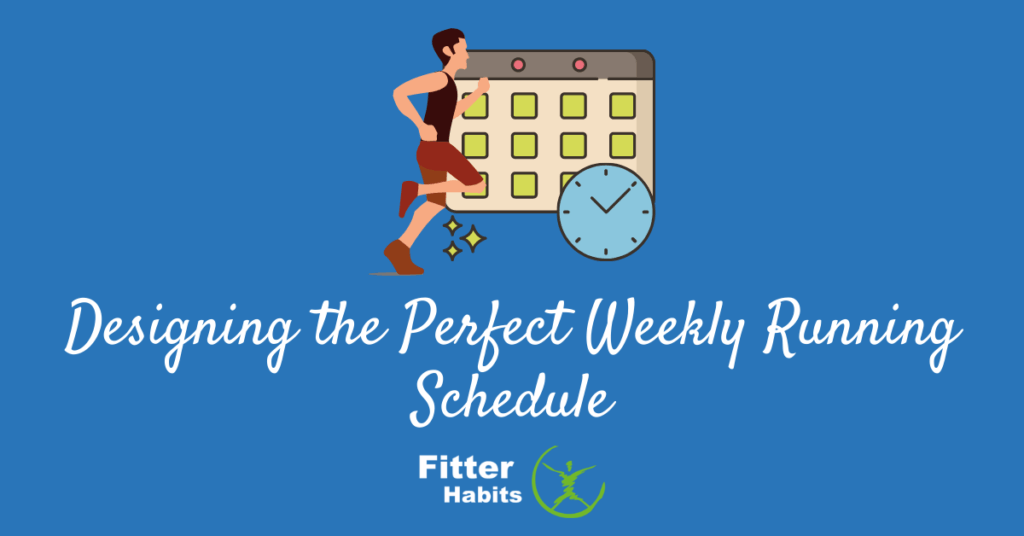Improving your fitness and strength as a jogger requires a disciplined and systematic approach. Start your training with an effective weekly running schedule.
If you’ve been jogging for a while and see no improvement in your strength or fitness levels, perhaps you’ve started to think, “I’m not made for running.” However, this is simply not true. Although it may be too late for you to join the U.S. Olympic team, it’s completely within your reach to become better at running and to up your health and fitness levels.
The secret of jogging success is pretty simple — design an effective weekly running schedule.
Contents
Why Is A Weekly Running Schedule Important?

Like most other things in life, improving your fitness levels through jogging will be much easier if you have a plan and stick to it. Creating a weekly running schedule typically involves setting achievable goals for yourself, which will help you to monitor your progress. Plus, achieving your goals, even if they are small, will keep you focused, motivated, and optimistic.
Chances are that if you’re going to design your own running schedule, you’ll do some online research. Doing so will help you understand the sport and how the body works a bit better.
Considering the insights you’ve gained through your research will help you design a jogging schedule that suits your specific lifestyle and needs, and can also prevent you from injuring yourself.
Things to Consider For Your Weekly Running Schedule
Here are a few main points you want to think about when you’re drafting your running schedule:
Mileage
Especially if you’re a new runner, the question of how many miles you should jog a week is an important one. Your ideal weekly mileage will vary depending on factors such as your fitness level and training goals. For instance, if you’re training for a marathon, you’ll probably need to average about 40 to 60 miles a week.
Conversely, beginners should start off by doing three to four runs a week that last from 20 to 30 minutes. Until you become a bit fitter and stronger, it may be better to plan your jogs according to time spent on the road rather than measuring distance.
Take Days Off
One of the biggest mistakes you can make is to try to run every day. This may sound counterproductive when you’re aiming to improve your fitness levels and increase your stamina. However, it’s vital to take a break from running a few days a week in order for your body to repair any damage, strengthen tissue, and build muscle.
Although seasoned joggers naturally train harder and more often than beginners, they most definitely take days off from running too. Over-training weakens the body and increases the chances of injuries, which for joggers often mean shin splints, runner’s knee, Achilles tendonitis, hamstring injuries, or IT band syndrome.
Incurring injuries can force you to take time off from running for a prolonged period, or could lead to more serious problems if you continue jogging with injuries.
Vary Your Jogging
A great way to increase your fitness levels and also prevent injury from repetitive motion is to schedule different types of jogs in your week. Experts recommend that you incorporate these runs in your training schedule:

- Speed runs: Doing a speed run entails running as fast as you can for short distances and then taking a break by walking or running slowly. Even if the distance you run for the accelerated bits is very short and your rest intervals quite long, this type of running greatly improves your aerobic capacity and your muscle strength.
- Tempo runs: A tempo run involves running a section of your jogging route slightly faster than your typical long-distance speed. You can start off at a comfortable pace, push yourself a bit harder in the middle section, and then slow down again for the last part of your jog. The aim of tempo running is to train your body to sustain faster running for longer periods.
- Long runs: Apart from building strength, you also want to work on your endurance. This you can do by working longer runs into your weekly jogging schedule. You can aim to increase your typical distance by a few minutes to start off with and can then gradually increase the distance as you get fitter.
Incorporate Strength And Cross-Training
Improving your jogging fitness requires more than just spending time on the road running. You also need to strengthen your muscles through strength training. This type of training reduces your injury risk since muscular strength and stability help to minimize the impact that running has on your joints.
In addition, strength training also helps you run faster, as your muscles don’t have to use as much energy to hit a certain pace.
Strength training doesn’t necessarily mean pushing weights in the gym. You can also strengthen your body through exercise disciplines such as Pilates or yoga. Incorporating other types of exercises, such as swimming or cycling, is also very beneficial.
Utilizing and strengthening muscles that you don’t typically use in running through alternative exercises such as these, will improve your jogging performance and can help prevent injury.
An Example of A Weekly Running Schedule
Although you should tailor your weekly running schedule according to your fitness and health levels, it may be beneficial to look at an example of one before you set out to design your own. Here’s a sample of a weekly running schedule for a beginner:
- Monday: Do a tempo run of around 30 minutes. If you know your route, you can either decide the points in the route where you plan to run at a faster-than-normal pace, or you can plan according to time. Depending on your fitness levels, you can jog at a comfortable pace for six minutes, then push yourself for 18 minutes, and then slow down again for the last bit.
- Tuesday: As you want to take a break from running every other day, use this day for a yoga or Pilates session, or hit the gym for some strengthening exercises.
- Wednesday: Opt for either hill workouts, which involves doing hill sprints and then walking or lightly jogging back down. The number of repetitions will depend on your fitness level and the length and gradient of the hill. Or, use this day for a speed run. A track is a great place for this type of exercise, as you can run 400 meters at top speed, and then slow down for 400 meters again. Repeat as many times as you can handle.
- Thursday: As is the case with Tuesday, you can use this day for strengthening exercises, or you can opt for alternative forms of exercise, such as swimming or a team sport at your local club.
- Friday: Take a break from training.
- Saturday: Weekends are the best time to fit in a longer run. Either plan to jog for a longer time, ie 40 or 45 minutes, or aim for more miles.
- Sunday: Take a break from training.
Final Word on A Weekly Running Schedule
Getting running fit requires more than just hitting the tar. In order to get in top shape and prevent possible injuries, you need to plan your exercise routine. Ensure that you develop and stick to a balanced routine by drafting a weekly running schedule.
FAQs About A Weekly Running Schedule
Should I incorporate stretching in my weekly running schedule?
Whether you should stretch before a jog is an ongoing debate, with many medical experts stating that it’s best to warm up for a jog with light aerobic exercises. However, stretching should definitely be part of your training schedule.
Doing some stretching after a jog prevents stiffness and pain and also helps to maintain your flexibility and range of motion in general. Jogging actually shortens your muscles, which means you could lose mobility over time if you don’t lengthen your muscles through regular stretching exercises.
Can beginners train for a marathon?
Firstly, you don’t need to run long distances to gain health and fitness benefits from jogging. Running shorter distances regularly is absolutely fine if your aim is to have a healthier and fitter lifestyle. However, if your goal is to run a marathon, you can achieve this within six months if you’re healthy and stick to your training schedule.



